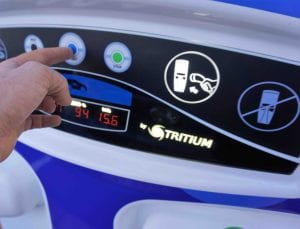Australia continues to deliver good news on the growing share of renewables in the main electricity grid, and the resulting fall in electricity sector emissions.
But the story elsewhere in the energy sector is less flattering. If you thought that Australia’s emissions targets are weak, and likely to be missed, its energy efficiency and productivity targets are even more so.
And, pathetically, because the country is also failing to meet even those modest goals, the resulting energy profligacy is burning unnecessary amounts of fossil fuels, and a huge hole in consumer wallets as well.
The latest monthly National Energy Audit – prepared by analyst Hugh Saddler on behalf of The Australia Institute – notes that Australia is failing hopelessly in its modest goal of achieving a 40 per cent improvement in energy productivity by 2030.
It is often forgotten that most of the energy created by burning coal and gas for generation, or manufacturing, or petrol and diesel for internal combustion engines in cars and trucks is lost as waste heat – two-thirds of it is wasted in most coal generators, up to 80 per cent in most cars.
Energy efficiency experts have been saying for a decade or more that this can be addressed – and deliver cost savings and all sorts of other benefits at the same time – an “energy trifecta” rather than the commonly described “energy trilemma”.
The energy efficiency experts say energy productivity should and could easily be doubled by 2030, or at least by 2025 since we’ve lost a few years doing nothing. Instead, fossil fuel interests, who make money when coal, gas, petrol and diesel are burned in great quantities, are getting in the way.
Australia trails the world on fuel efficiency standards for cars, thanks to the lobbying of the car and fuel transport industries, and the scare-mongering of the Murdoch media.
Any attempt to discuss new goals has been shouted down by conservatives as a “carbon tax on wheels”, but it is costing consumers a bomb ($600 a year in extra fuel for cars according to the government’s own estimates) and it is causing emissions to rise, as well as harmful particulates.
Utilities, of course, have also fought energy efficiency and demand management initiatives at every turn in the electricity market, because it would mean burning less fossil fuels, and while it would mean lower bills for consumers, it would also mean lower profits for utility shareholders and smaller bonuses for its managers.
Saddler notes that Australia is now the fourth worst performing country in the OECD on energy emissions – which includes transport, manufacturing, and buildings. Some 27 countries have actually lowered their energy emissions in the last decade. Only eight countries increased these emissions, and only Turkey, Mexico and South Korea did worse than Australia.
“It is not enough for Australia to rely on falling generation emissions to achieve reductions in total emissions,” Saddler writes in his latest report.
“It must become serious about reducing transport emissions and increasing the efficiency, and hence productivity, of energy use in manufacturing, mining and all other sectors.”
This graph below tells the sorry tale. Electricity emissions are down, thanks to the growing share of wind and solar, but everywhere else it is up – thanks to the increased use of diesel in mines, petroleum in cars and trucks, gas in LNG plants, and gas in manufacturing and buildings.
Indeed, the Australian Alliance for Energy Productivity has had a long running campaign, 2xEP, that outlines how Australia can easily meet a doubling in energy productivity, and reduce emissions, boost GDP, and lower costs all at the same time.
It said in a recent assessment report that the country has since 2015 gone horribly off track in its 40 per cent improvement target for 2030.
“The Commonwealth Government has neglected the NEPP, energy productivity has flatlined and there is no coherent national energy/carbon policy framework to support the transition of our economy to its future state,” it notes.
“2xEP can be done with existing technologies on an economically efficient and effective pathway. The outcome? A significant boost to GDP,” it says.
Or, in the terminology of the current government, it means jobs and growth, and lower bills for the quiet Australian. The A2SE group helpfully produces a document outlining how it can be done – such as setting useful targets and putting policies in place. An electric vehicles strategy would be a good starting point.
A2SE says a 4.5 per cent lift in energy productivity will double productivity by 2035. It needs targets, incentives, education programs for consumers, and a tightening of codes in building and transport, and to ensure they are fit for the future.
Again, if you don’t have a go, how can you possibly get a go? But who listens to experts these days when Sky News commentators are foaming at the mouth, scaring the common sense out of government policy-makers?











